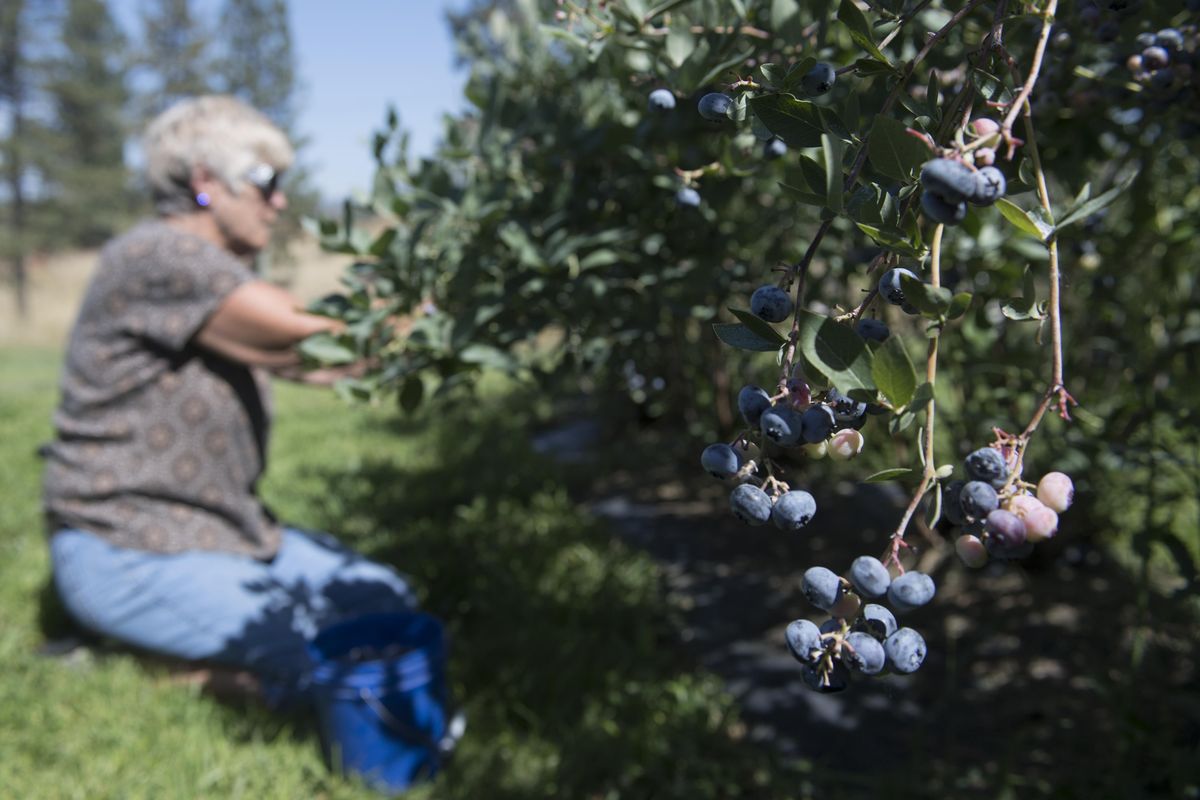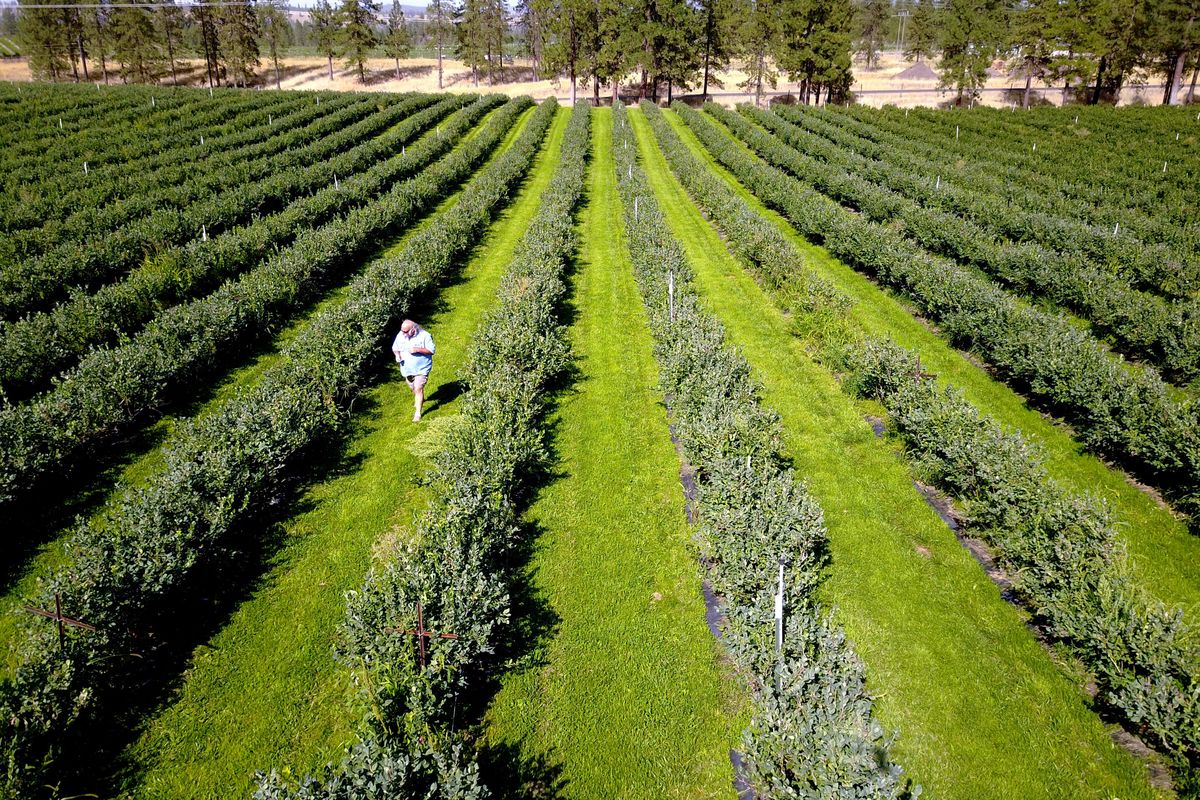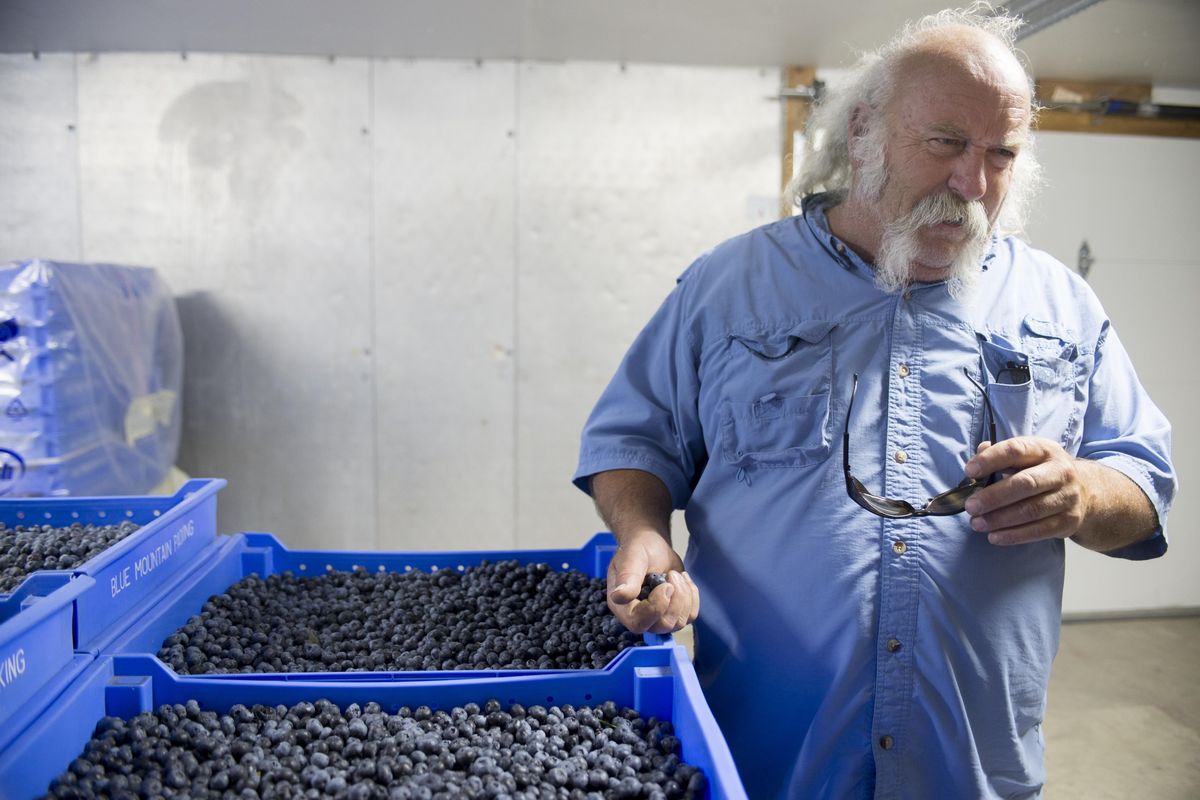
Farmers go into the blue: Washington is tops in the country in blueberry production
Janice Baker needed another bucket.
She was kneeling on the grass between rows at the end of the season, but she was mighty impressed with the size of the organic fruit still hanging on. “That is a big blueberry!” she exclaimed, holding up a specimen nearly the size of nickel.
“This,” she said, “is good picking.”
Steve Walser walks his park-like blueberry field at his farm north of Reardan Thursday, Aug. 24, 2017. I just love coming down here, walking the field and eating blueberries, he said. Most of the bushes are done bearing by this time of year, but there are a few here and there. Jesse Tinsley/THE SPOKESMAN-REVIEW (Jesse Tinsley / The Spokesman-Review)Buy a print of this photo
Blueberry production has ramped up across Washington during the past 10 years, including in Eastern Washington, where blueberries traditionally weren’t grown until relatively recently.
Washington now ranks No. 1 in the country for overall blueberry production. In fact, Washington produces more organic blueberries than the rest of the states combined, according to Alan Schreiber, executive director of the Washington Blueberry Commission in Eltopia, north of Pasco.
“People historically liked blueberries because they tasted so good,” Schreiber said. “But there were some studies done, and we saw growth across the board. The health effects of blueberries really stimulated consumption and so the demand went up, the price went up and growers started planting.”
That demand kept increasing. And farmers in Washington, Schreiber said, “planted a lot of blueberries.”
Gleaning the crop
In late August, when most of the rows were already harvested, Baker, 70, of Chattaroy, and two friends were enjoying “a girls’ day of picking” at Willow Wind Farms, situated northwest of Spokane. Signs had directed them to rows 101-103, where they had been picking – and bantering back and forth between blueberry bushes – for not quite two hours.
“I’m going to be stiff and sore,” said Baker, as she starting to fill a second pail. “My husband better enjoy this effort.”
She was planning to bake him a pie.
While Baker was pleased with her two pails – one brimming, one just beginning – her haul was just a blip in the season’s blueberry harvest at Willow Wind.
“We’re a production farm,” said blueberry grower Steve Walser, who provides U-pickers with buckets and relies on the honor system to get paid for the fruit. Guests weigh their own and place payment in a drop box. “It’s very low-maintenance. I really only did U-pick because I want local people to be involved with the farm.”

Blueberries from Willow Wind get shipped throughout the country. Walser is one of the local leaders in Eastern Washington’s burgeoning organic blueberry industry, which is – along with conventional, or nonorganic, blueberries – in the midst of a dramatic period of growth and change.
Last year, Washington’s total harvest came in at 120 million pounds, or six times what it was 10 years ago, Schreiber said. It’s projected to weigh in at about 132 million pounds this year. And next year – assuming normal pollination and no drought – Schreiber projects the state’s blueberry harvest could reach 145 million pounds.
Washington became the national leader in blueberry production in 2015, when it surpassed Georgia – which actually produces more blueberries these days than its famous peaches. Behind Washington and Georgia in blueberry production are Michigan and Oregon.
In all, there are about 18,000 acres of blueberries in Washington. Of that, about 5,000 acres are in Eastern Washington, which now produces about 40 percent of this state’s blueberry crop. “Eastern Washington has some of the largest blueberry growers in the world – all the way down to people who farm just a few rows of blueberries,” Schreiber said.
Whatcom County on the West Side still produces more than any other county in the state, with at least 7,000 acres of blueberries – a record number – twice as much as it grew in 2010. A third of those plants are 4 years old or younger.
Statewide, there’s significant new production from young fields. And Washington will continue to experience that growth. Last year, at least 1,000 new acres of blueberries were planted in this state.
The push to grow more blueberries in Washington, particularly in Eastern Washington, started about 10 years ago. Before then, most of the blueberries grown in Washington were grown in Western Washington and were conventional. Now, organic blueberries make up about a quarter of the total crop, Schreiber said.
Not only is organic and conventional blueberry production on the rise in Washington, but it’s also up worldwide – by 40 percent from 2012 to 2016, according to the U.S. Highbush Blueberry Council.
Consumption soaring
Popping plump, juicy, bush-ripe blueberries right into your mouth is one of the simplest and most sublime satisfactions of summer. But consumers are enjoying them much more than just as a fresh summertime snack. According to the U.S. Highbush Blueberry Council, blueberry consumption in America grew by a whopping 599 percent in the 20-year period from 1994 to 2014. And, as Schreiber noted, that demand continues to increase.
Industry experts, including him, credit recent studies that show berries are a good source of natural antioxidants for the boost in demand and production. Often referred to as a “superfood,” blueberries are rich in vitamin C, manganese and more.
Plus, they taste good.
Gently sweet with just a whisper of tartness, blueberries can be used in both sweet and savory dishes. Tuck them into muffins, tarts, pies and other baked goods. Or, add them to pancakes, smoothies, salads, sauces, syrups, ice pops or ice cream. Use them to top yogurt or oatmeal or roast. Make them into jam.
Walser’s favorite way to eat them: plucking them right off the bush and popping them in his mouth. During blueberry season, he walks through his rows, eating blueberries daily right off the bushes. It’s a form of quality control.
“I love growing blueberries,” he said. “I have grown everything there is to grow – in the Northwest, that is. And they’re a challenge. Not everyone can do them.”
But, “They’re so rewarding.”
‘The economics of it’
Walser, whose blueberries are sold under the Naturipe label, first planted blueberries in 2009. “I saw the economics of it,” he said, noting blueberries, especially organic blueberries like the ones he grows not far from the southwestern shores of Long Lake near Ford, can be a lucrative crop – particularly later in the season when blueberries fetch a higher price.
He started with 15 acres. Today, he grows nine varieties on about 33 acres and wants to expand – to some 100 to 150 acres of blueberries.
“This was my retirement project,” he said, noting he was “relatively late” to the blueberry game. “I wish I had started 10 or 15 years before.”
Inspired by the back-to-the-land movement of the mid-1960s and ’70s, Walser began farming some 40 years ago. He bought this farm about five years after he got started, adding onto the acreage as he could. He grew potatoes back then. And he still grows other crops: hay, cherries, peaches, apricots, raspberries and, under the auspices of another business called Buddy Boy Farm, cannabis.
Blueberries aren’t as lucrative as marijuana. But, Walser said, “The blueberries are making more money than the hay right now. The price escalates this time of year.” Growers, he said, “are trying to get into that late market. It’s where the money is. They’ll play around with everything” – planting new varieties and test rows, for example – “so they can get there.”
On the low end, organic blueberries fetch about $2.50 per pound to as much as $8 or $9 per pound for the farmer, he said. Nonorganic might top out at around $4.50 per pound, he said.
They’re all harvested by hand.
And that’s one of the challenges for the industry, Schreiber said. When it comes to labor, he said simply, “We do not have enough.”
Of the farmworkers the blueberry industry does have, legal status can also be a concern. Based on a national study, Mike Gempler, executive director of the Washington Growers League, estimates about half of Washington farmworkers are undocumented – although, for some come crops, that percentage could be even higher.
Walser said he’s lucky; he usually doesn’t have trouble finding farmworkers for blueberry harvest. Most come from Spokane. Eight to 10 members of his crew return year after year.
Blueberry harvesters are paid by how much they pick. At the very least, they make minimum wage, which in Washington is $11, one of the highest in the country. In addition to a shortage of labor, the cost of labor is also a concern, Schreiber said.
Walser pays pickers 55 cents per pound, plus a bonus at the end of the season if they stay on through the end. Work is five days a week for about two months. Expert pickers can make around $250 per day, arriving as early as 5 a.m. to harvest during the cooler morning hours and quitting for the day around 1 p.m.
Grass grows between rows to keep the dust down and off the berries as well as maintain moisture. From here, berries go straight to cold storage, where they’re cooled to 31 or 32 degrees.
In all the varieties Walser grows, “The differences are really subtle.”
Unlike with apples, however, most consumers don’t really seem too concerned about blueberry varieties. Other than a few direct-market exceptions, such as farmers markets and, sometimes, U-pickers, consumers generally just want typical blueberries. Few varieties are labeled in supermarkets. So growers like Walser can select varieties to extend their season and offer better berries to wholesale firms, packing sheds or retailers.
This year, Walser’s favorite is Blue Crop, a hardy, flavorful variety. He also likes Liberty blueberries “because they’re so sweet.” Draper is also “a really good variety. It’s not a very big bush, and it gets loaded with berries.” It used to be his favorite.
Duke ripens midseason. And those berries, Walser said, seem to “hang on the bush forever. They get big. They’re forgiving. They just sit there, getting sweeter.”
Four ‘vibrant’ sectors
Production in Washington is made up of four sectors: organic fresh, organic processed, conventional fresh and conventional processed. “All four of those are very vibrant industries in Washington,” Schreiber said.
That’s partially because the blueberry plants here are some of the highest-yielding in the world, Schreiber said, noting they provide some 20,000 to 25,000 pounds per acre at maturity, even the organic fields.
Washington’s also particularly well-suited for blueberry production because it enjoys a wide temporal range for harvest. “We have the climate,” Schreiber said. “We also have a five-month picking window. No other state has that. Eastern Washington is early. Northwest Washington is late. We start picking the first week of June and we go until the middle of October.”
Washington is also home to some of the latest plantings in the country as well as the best varieties, technologies and post-harvest handling facilities, Schreiber said.
In Eastern Washington,“We don’t have the pest pressure that they have in a lot of places,” he said. “It’s easy to grow organic berries here. As a result, we grow as many organic blueberries here in Washington than the rest of the country combined.”
Last year, however, the industry didn’t have the capacity to fresh-pack or process the entire crop it produced. In fact, Schreiber estimates that at least 40 percent of Washington’s blueberry crop is packed or processed out of state. Oregon and British Columbia are primary destinations. But more than 2 million pounds each also go to Idaho and California, Schreiber said.
Washington’s blueberry industry “is leaving a lot of income on the table” by sending fruit out of state for packing and processing, he said.
Whatcom, Snohomish and Skagit counties on the West Side, and Benton and Franklin counties in Eastern Washington, and are the state’s top blueberry-growing areas. In northwest Washington, Schreiber said, there’s a need for increased fresh-pack capacity. And in Eastern Washington, he said, there’s a need for increased freezing capacity. “My No. 1 concern is: How do we manage an industry that is rapidly moving to producing 200 million pounds of fruit?”
Exports, competition
Schreiber wants to expand Washington’s blueberry exports – particularly to the Pacific Rim, including South Korea, India and Australia. Few blueberry growing regions are better situated for exports to that part of the world than Washington is, he said.
Imports are a growing concern, particularly from Peru, which can produce blueberries year-round and where production costs less.
There are challenges on the homefront, too. One is whether – or, rather, when – supply is going to outstrip demand.
Then, there are pests, such as spotted wing drosophila – small flies with red eyes that lay eggs in berries and stone fruit. Because of bugs and disease, it’s difficult to grow organic berries in Western Washington.
Eastern Washington, on the other hand, is almost an ideal place to grow blueberries, including organic blueberries. It is, for the most part, disease-free and pest-free.
“Here in Eastern Washington, we don’t have that many challenges,” Schreiber said. “Our issues would be getting enough people to pick blueberries and the high cost of labor.”
Another challenge is the soil itself. Blueberries, “are picky about that pH. They like low pH, really acidic soil. We start a year in advance prepping the fields,” Walser said, noting two years would be even better. “We have to really build the soil.”
The process involves adding compost, manure, sawdust, sulfur and rock phosphate to the soil well before planting. But that investment pays off. Blueberry plants, Walser said, “don’t really decline as long as you treat them well – and they don’t get some disease.”
So far, disease hasn’t been a major concern for blueberry growers on the East Side of the state. And Walser gives great care to his crop. He checks on them daily during blueberry season.
“I come down here every day and eat blueberries,” he said. “They’re all good. There are no bad ones.”







